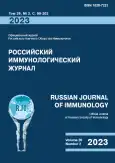Иммунорегуляторные эффекты локального и системного применения мелатонина при экспериментальной термической травме
- Авторы: Осиков М.В.1,2, Агеева А.А.1, Бойко М.С.1, Агеев Ю.И.1
-
Учреждения:
- ФГБОУ ВО «Южно-Уральский государственный медицинский университет» Министерства здравоохранения РФ
- ГБУЗ «Челябинская областная клиническая больница»
- Выпуск: Том 26, № 2 (2023)
- Страницы: 123-128
- Раздел: ОРИГИНАЛЬНЫЕ СТАТЬИ
- URL: https://journals.rcsi.science/1028-7221/article/view/253386
- DOI: https://doi.org/10.46235/1028-7221-9408-IEO
- ID: 253386
Цитировать
Полный текст
Аннотация
Распространенность термической травмы, высокий риск инфекционных и неинфекционных краткосрочных и долговременных осложнений, ограниченная эффективность применяемых терапевтических подходов являются предпосылкой для поиска и патогенетического обоснования новых средств терапии, среди которых внимание привлекает эндогенный регулятор гомеостаза с плейотропными свойствами – мелатонин.
Цель работы – изучить влияние локального в составе оригинальной дермальной пленки и системного применения мелатонина на концентрацию TNFα и IL-4 в сыворотке при экспериментальной термической травме.
Скорость эпителизации высчитывали в %. Концентрацию в плазме IL-4, TNFα определяли на автоматическом иммуноферментном анализаторе Personal LAB (Италия).
При ТТ от 5-х к 20-м суткам эксперимента увеличивается скорость эпителизации раны. В условиях применения ДП с МТ при ТТ на 5-е, 10-е и 20-е сутки зафиксировано увеличение скорости эпителизации раны. В условиях внутрибрюшинного применения МТ при ТТ на 10-е и 20-е сутки увеличивается скорость эпителизации раны. Проведенный нами корреляционный анализ позволил выявить, что при ТТ в условиях применения ДП с МТ более сильные связи, чем в условиях применения МТ внутрибрюшинно, а значит быстрее проходят процессы репарации, снижается площадь альтерации и уменьшается синтез цитокинов в сыворотке.
При ТТ концентрация TNFα и IL-4 повышается в сыворотке крови на 5-е, 10-е и 20-е сутки. На 10-е и 20-е сутки были зарегистрированы умеренные положительные ассоциации между скоростью эпителизации раны и концентрацией цитокинов в сыворотке крови. Внутрибрюшинное применение МТ с ТТ на 5-е, 10-е и 20-е сутки увеличивает скорость эпителизации, на 10-й и 20-й дни концентрация TNFα снижается. На 5-е, 10-е и 20-е сутки были зарегистрированы умеренные негативные ассоциации между скоростью эпителизации раны и концентрацией TNFα. В условиях применения ДП с МТ с ТТ скорость эпителизации раны увеличивается на 5-е, 10-е и 20-е сутки, концентрация TNFα в сыворотке крови снижается, концентрация IL-4 снижается на 10-е сутки. На 5-е, 10-е и 20-е сутки были зарегистрированы отрицательные ассоциации между скоростью эпителизации раны и концентрациями TNFα и IL-4 в сыворотке крови. Сравнительный анализ эффективности применения ДП с МТ, в отличие от внутрибрюшинного применения МТ с ТТ, выявил более ускоренную эпителизацию раны и раннее снижение TNFα, большее количество и силу взаимосвязи между скоростью эпителизации раны и концентрацией содержание цитокинов в сыворотке крови.
Ключевые слова
Полный текст
Открыть статью на сайте журналаОб авторах
Михаил Владимирович Осиков
ФГБОУ ВО «Южно-Уральский государственный медицинский университет» Министерства здравоохранения РФ; ГБУЗ «Челябинская областная клиническая больница»
Email: ritkaboyko@yandex.ru
д.м.н., профессор, заведующий кафедрой патофизиологии ФГБОУ ВО «Южно-Уральский государственный медицинский университет» Министерства здравоохранения РФ; руководитель отдела научной работы ГБУЗ «Челябинская областная клиническая больница», г. Челябинск, Россия
Россия, г. Челябинск; г. ЧелябинскАнна Алексеевна Агеева
ФГБОУ ВО «Южно-Уральский государственный медицинский университет» Министерства здравоохранения РФ
Email: ri-tochka9@list.ru
ассистент кафедры патофизиологии ФГБОУ ВО «Южно-Уральский государственный медицинский университет» Министерства здравоохранения РФ, г. Челябинск, Россия
Россия, г. ЧелябинскМаргарита Сергеевна Бойко
ФГБОУ ВО «Южно-Уральский государственный медицинский университет» Министерства здравоохранения РФ
Автор, ответственный за переписку.
Email: ritkaboyko@yandex.ru
ассистент кафедры патофизиологии ФГБОУ ВО «Южно-Уральский государственный медицинский университет» Министерства здравоохранения РФ, г. Челябинск, Россия
Россия, г. ЧелябинскЮрий Иванович Агеев
ФГБОУ ВО «Южно-Уральский государственный медицинский университет» Министерства здравоохранения РФ
Email: ri-tochka9@list.ru
к.м.н., доцент кафедры патофизиологии ФГБОУ ВО «Южно-Уральский государственный медицинский университет» Министерства здравоохранения РФ, г. Челябинск, Россия
Россия, г. ЧелябинскСписок литературы
- Boutin J.A., Ferry G. Is there sufficient evidence that the melatonin binding Site MT3 is Quinone Reductase 2? J. Pharmacol. Exp. Ther., 2019, Vol. 368, no. 1, pp. 59-65.
- Dong K., Goyarts E., Rella A., Pelle E., Wong Y.H., Pernodet N. Age associated decrease of MT-1 melatonin receptor in human dermal skin fibroblasts impairs protection against UV-induced DNA damage. Int. J. Mol. Sci., 2020, Vol. 21, no. 1, 326. doi: 10.3390/ijms21010326.
- Favero G., Franceschetti L., Bonomini F., Rodella L.F., Rezzani R. Melatonin as an anti-inflammatory agent modulating inflammasome activation. Int. J. Endocrinol., 2017, Vol. 2017, 1835195. doi: 10.1155/2017/1835195.
- Galano A., Tan D.X., Reiter R.J. Melatonin: a versatile protector against oxidative DNA damage. Molecules, 2018, Vol. 23, no. 3, 530. doi: 10.3390/molecules23030530.
- Hardeland R. Aging, melatonin, and the pro- and anti-inflammatory networks. Int. J. Mol. Sci., 2019, Vol. 20, no. 5, 1223. doi: 10.3390/ijms20051223.
- Lateef Z., Stuart G., Jones N., Mercer A., Fleming S., Wise L. The cutaneous inflammatory response to thermal burn injury in a murine model. Int. J. Mol. Sci., 2019, Vol. 20, no. 3, 538. doi: 10.3390/ijms20030538.
- Loynes C.A., Lee J.A., Robertson A.L., Steel M.J., Ellett F., Feng Y., Levy B.D., Whyte M.K., Renshaw S.A. PGE2 production at sites of tissue injury promotes an anti-inflammatory neutrophil phenotype and determines the utcome of inflammation resolution in vivo. Sci. Adv., 2018, Vol. 4, no. 9, eaar8320. doi: 10.1126/sciadv.aar8320.
- Mayo J.C., Aguado A., Cernuda-Cernuda R., Alvarez-Artime A., Cepas V., Quiros-Gonzalez I., Hevia D., Sáinz R.M. Melatonin uptake by cells: an answer to its relationship with glucose? Molecules, 2018, Vol. 23, no. 8, e1999. doi:10.3390/ molecules23081999.
Дополнительные файлы







